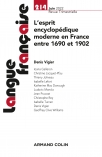
Littérature Nº198 (2/2020)
Pour acheter ce numéro, contactez-nous
Recevez les numéros de l'année en cours et accédez à l'intégralité des articles en ligne.
Dès la fin du XVIIe siècle, Perrault et ses amies ont donné à la terreur un rôle fondateur dans le nouveau genre du conte de fées. C’est Addison qui en 1712, dans le Spectator, s’appuie sur ces exemples pour concevoir son esthétique de « l’horreur agréable ». Burke radicalise son propos en 1757 avec la théorie de « la terreur sublime », qui vient s’appliquer aux contes de d’Aulnoy, de Villeneuve et de son compatriote francophone Beckford. Cette veine originale, ainsi déployée dans les oeuvres et les réflexions poétiques des deux côtés de la Manche pendant un siècle, vient ensuite nourrir la nouvelle fantastique romantique, tandis que Grimm et Andersen s’en emparent pour en changer radicalement le sens et la portée.
As soon as the end of the 17th century, Perrault and his female friends have conferred on terror a founding part in the new genre of the fairy tale. It is Addison who, in 1712, in The Spectator, relies upon these examples to conceive his aesthetics of « the pleasant horror ». Burke hardens his prospect in 1757 with the theory of « the sublime terror » which is epitomized in the tales of d’Aulnoy, of Villeneuve and of his French-speaking fellow countryman Beckford. This original inspiration, thus displayed in works and poetic reflections on either side of the Channel during a century, then nurtures the Romantic tale of fantasy, whereas Grimm and Andersen take hold of it to change its meaning and scope in a radical way.

